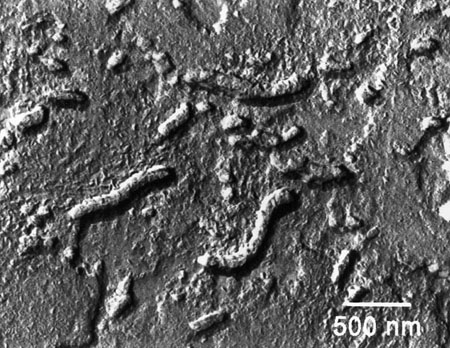Possible nanobacteria embedded in Martian meteorite
There are in this world a small number of very fortunate people who are able to make an honest and decent living by writing blogs. Good on them, that's an impressive accomplishment. I, on the other hand, have never made a dime writing this blog. Which is fine; this is a hobby for me, and I make my living in other ways which I love and which I think are at least as cool as blogging. However, one of the realities of the fact that I am gainfully employed in the maritime industry is that 1) there are occasionally longish gaps in this blog, some of which occur at times that I might otherwise want to contribute to it and 2) sometimes when I finally am in front of a computer I am unable to find links to news articles and other things which occurred when I did not have access to the internet.
As a rule I try to source anything I post here which I myself do not write. Due to the aforementioned, with apologies, this won't be one of those times.
So. Somewhere in the past week, I saw an article (believe it or not, I don't think it was Fox News this time) discussing the current NASA budget. Specifically it was discussing the fact that prior to landing humans on Mars, we want a robot probe to bring a sample of Martian soil back to earth to analyze for possible microbial life.
This much is essentially true.
However, the article then went on to state that the reason for this is that NASA is concerned that martian microbes might bear disease which could infect human explorers.
Oh dear.
I am, for the record, not a biologist, so perhaps my understanding of such things is too limited. But it seems to me rather unlikely that an organism which has evolved over millions of years to thrive on a parched, frozen and nearly airless world would find the warm, wet interior of a human body a very hospitable place.
On earth, disease organisms tend to be very host-species specific, and co-evolutionary with their hosts. There are a few diseases such as rabies which are transmissible between different mammals, and still fewer diseases which are transmissible between endothermic vertebrates (such as avian influenza). But this is not the general rule. Veterinarians do not need to be nearly so cautious about fluid-borne pathogens as their human-medicine counterparts, for this very reason.
Even more rare on earth are pathogens which are not transmitted by other organisms, but rather directly from the environment. Amoebic dysentery is an example of this, where a prokaryote which thrives in warm, still water also happens to thrive, unsurprisingly, in the human body. Trichophyton (athlete's foot, ringworm etc) and other fungal infections also require warm, wet environments.
Similarly, on earth there have been many examples of organisms from one region being introduced into a different region and thriving, even in some cases out-competing native organisms of similar niches. One of the most extreme examples of this is kudzu, an ornamental ivy from Japan which now threatens to eradicate most of the US states in the southeast (although probably not quickly enough to have any beneficial effect on the 2012 elections). Again, the new temperate environment was only slightly different from the old temperate environment.
When we relocate species from their native environment to a radically different one, even within the same climatological zone, we find a very different outcome. Consider two terrestrial vertebrate apex-predators, the Bengal tiger and the great white shark. A healthy adult great white shark deposited in the grasslands below the Himalayas is probably not going to successfully out-compete the native tigers. Similarly, a healthy adult Bengal tiger relocated to the middle of the Indian ocean is not going to seriously impinge upon the shark's hunting grounds. And yet, these two environments are remarkably similar, in terms of temperature, humidity, barometric pressure, gravity, environmental chemistry, solar and cosmic radiation; even the length of the day and year are similar. More importantly, the organisms themselves are remarkably similar. Form does, after all, follow function, and they also have a common evolutionary ancestor. And yet, neither can survive for more than a few minutes in the other's native habitat.
Now, consider Mars.
The average surface temperature on Mars is -63° C (-81° F). Rarely, at the equator, temperatures at the very surface reach 20° C (68° F), but even then the temperatures just a few inches above that are sub-arctic. Average barometric pressure on earth is 1013 millibars. Average barometric pressure on Mars is about 6 millibars, which is less than the inside of an early vacuum tube. Martian atmosphere is 95% carbon dioxide, with 210 ppm water vapor. Earth's atmosphere is 78% nitrogen and 21% oxygen, with about 25,000 ppm water vapor at the surface.
Martian life, if such exists, cannot survive in earth's atmosphere, or within the bodies of organisms which evolved within that atmosphere. Just as importantly, terrestrial organisms cannot survive on Mars. In the case of Mars, we do not need a "microbial Prime Directive". We could bombard Mars with terrestrial bacteria for weeks, and within minutes of their landing on the Martian surface they would all be dead and frozen. Similarly, we do not need to worry about an "Andromeda Strain" being returned from Mars to earth. The greatest difficulty will be keeping any organisms alive long enough to study them.

No comments:
Post a Comment